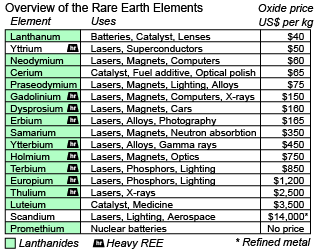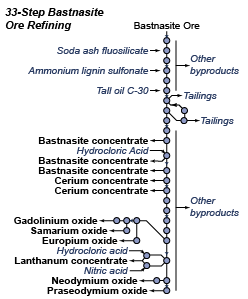- Summary
- Uses and abundance
- Current Production and potential domestic sources
- Environmental Concerns
- REEs in Alaska
Summary
Rare Earth Elements (REEs) are critical components of a wide variety of military and civilian technologies, including many “green” applications. However, their processing and extraction has significant environmental cost. China produces virtually all the world’s REEs, and recent export restrictions have renewed interest in domestic development. Significant deposits include an almost-ready mining operation in California and a deposit in Alaska with an unusual abundance of certain REEs.
Uses and abundance
Seventeen elements form the group known as the Rare Earth Elements (REEs): the 15 lanthanides, yttrium, and usually scandium. Current uses include catalytic converters, computers, cell phones, high-temperature magnets, batteries for hybrid and electric vehicles, medical devices, and military applications such as missiles, jet engines, and satellites.

Most rare earth elements are actually relatively abundant in the earth’s crust, but are rarely concentrated in economically useful forms With the exception of unstable promethium (estimated 572 grams total in the entire crust!), all the REEs are more abundant than silver or mercury. However, rare earths are not often concentrated in mineable deposits, and are almost always found in conjunction with significant radioactivity. Minerals that concentrate REEs usually contain more than one, and because of the chemical similarity between the elements, separating the mixture into usable fractions is time-consuming and expensive. Every ore deposit has a unique mixture of elements and minerals, thwarting standardization of the separation process. Therefore, these elements are “rare” mostly because of the difficulty associated with economically extracting them.
Current Production and potential domestic sources
Currently, around 97% of the world supply of REE’s comes from China, and in the last two years, China has begun to restrict exports. Although China denies employing restrictions as economic and political leverage, a freeze in exports to Japan in the fall of 2010 raised worldwide concern. Because of the widespread use of these elements in technology, particularly by the military, China’s recent actions coupled with a swift rise in prices during 2010 have prompted the US to examine domestic deposits with renewed vigor and funding.
Worldwide demand for REEs in 2010 was 125,000 tons, and rising fast. A November 2010 study by the USGS estimated that the US possesses around 13 million tons of REEs in known domestic deposits. Only one of these domestic deposits has been explored enough to estimate mineable “reserves”; the remainder are rough resource estimates. The time to develop an unexplored deposit to a working mine could be over a decade.
The deposit closest to production is an existing REE mine that stopped production in 2002, due to a combination of environmental problems and competition from China. The Mountain Pass rare earth mine in California operated for around 50 years and at one time produced most of the world’s REEs. After partial closure in 2002 the mine continued to process some of its previously mined ore on site. The new owners of the mine, Molycorp Minerals LLC, are undertaking an extensive modernization and expansion at the mine, and expect to re-enter full production in 2012. In addition to mining the ore, the company also plans to perform some processing on-site for the first time.
Other major domestic deposits are found in Wyoming, Colorado, and Alaska. However, these deposits are only in the exploratory phase.
Environmental Concerns
Rare earths present a difficult environmental conundrum. They are required for a variety of “green” technologies, including wind turbines and hybrid/electric cars. Production of an electric car is currently not possible without neodymium and dysprosium, which are both important components of the magnets used in the engine. However, the extraction and processing of rare earths has significant environmental risks in its potential for spread of radioactive material and toxic chemicals, and the acidification of watersheds. And so their use assists in relieving one type of environmental strain, climate change, while risking another, in a complicated risk/benefit relationship.
As discussed above, REE’s are almost always found in conjunction with radioactivity, meaning that all the waste streams from mining (water, rock, and air pollution) can create a radioactive hazard. One of the major problems leading to the closure of the Mountain Pass mine was a series of radioactive wastewater spills from the mine facility totaling around 600,000 gallons of thorium-laced water. The largest REE mine in the world, near Baotou in China, has significant problems with water and air pollution. Some extraction techniques also involve depositing large amounts of acid directly onto the ore at the mine site. One estimate from China concluded that for each ton of rare earth brought to the surface, 200 square meters of vegetation and 300 square meters of soil were sterilized by acid treatment.

In addition to the direct impacts of mining such as the footprint of the mine and the problems with radioactivity, the processing of rare earths requires a number of intensive steps, often using toxic chemicals and acids. Separation of different REE’s from the complex mixture in ore can require dozens, or even hundreds of steps each with its own waste stream.
A number of observers in China, and around the world, have remarked that many companies are touting their “green” technologies at home, but are sourcing their rare earths from China, which bears all the environmental cost. A mine like Mountain Pass in the US is expected to have many more layers of environmental protection, but at a significant economic cost.
One partial solution would be to increase the recycling rate of these elements. Currently the recycling rate for most rare metals is around 1% or less. Japan is exploring increased recycling of rare earths from electronic waste, but reuse remains technically difficult and not economically feasible in many cases. However, as with all resource extraction, if the price of the final materials included the true cost of rare earth mining, the incentive to recycle would increase. Another option, also under active exploration in Japan, is to reduce the necessity for REEs in electronics, which will most likely be possible in some, but not all cases.
REEs in Alaska
Alaska possesses around 70 known deposits of REEs, most of which are totally uncharacterized. The most thoroughly explored deposits are both on Prince of Wales Island in the southeast portion of the state. The deposit at Salmon Bay hasn’t been explored by the USGS since the 1950’s, and its economic potential is unknown. However, active exploration rights to Salmon Bay and several other possible REE sites in the state are held by a company called Contago ORE Inc.
The Dotson Ridge Rare Earth project, located near the former Ross Adams uranium mine on Bokan Mountain, is being undertaken by Ucore Rare Metals. This deposit has anomalously high levels of the so-called “heavy rare earth elements” (HREEs). These elements, particularly dysprosium, are often found only in low concentrations within rare earth deposits yet are some of the most sought after REEs. Active exploration is currently underway at this site.
In light of the potential for REE development, the state of Alaska budgeted $500,000 for a “strategic assessment” of REEs in 2011. This study is taking place over three years and will examine the economic potential of a variety of deposits around the state on federal, tribal, and state lands. For example in April 2013 the DGGS released results of sample collections on Annette Island in 2012. In early 2015 the state released more detailed maps showed REE potential in a number of locations.
Further Reading
- > "From Mine to Magnet: Rare Earths A to Z" (2011) Article on Mineweb.
- > "Rare Earth Elements -- End Use and Recyclability" (2011) Produced by the USGS.
- > "Rare Earth Elements – Critical Resources for High Technology" (2002) Produced by the USGS.
- > "Rare Earth Elements in U.S. Not So Rare" (2010) Produced by the USGS
- > "The Principal Rare Earth Elements Deposits of the United States—A Summary of Domestic Deposits and a Global Perspective" (2010) Produced by the USGS
- > "Clean Energy's Dirty Little Secret" (2009) by the Atlantic Monthly
- > Wikipedia article on rare earth elements
- > 2008 Minerals Handbook, "Rare Earths" prepared by the USGS
- > "Study on Rare Earths and Their Recycling" (2011). Prepared for the European Parliament.
Created: Jan. 19, 2018